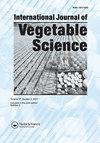饲料萝卜水提取物及相关根际细菌对番茄生长的生物刺激作用
IF 1.1
Q2 Agricultural and Biological Sciences
引用次数: 0
摘要
摘要使用生物兴奋剂可以减少合成化学物质的数量,从而促进番茄的生长和生产。本研究评估了与饲料萝卜(Raphanus sativus L.)及其水提取物相关的根细菌分离株B45、B46、B48、B54和B55在温室条件下促进番茄植株生长的能力。根际细菌的施用方法是先浸根,然后在种植时淋苗。基于宏观形态和生化特征对分离株进行了鉴定,并探讨了其促进植物生长(PGP)特征的机制。对于直接的PGP特性,分离株能够在无氮琼脂培养基上固定氮。分离株B45、B46、B54和B55对吲哚-3-乙酸的产生呈阳性;分离株B46、B48和B55对磷酸盐溶解呈阳性,其中B46表现出最高的活性。对于间接PGP特性,分离物是几丁质酶、脂肪酶和淀粉酶的产生剂。根据16S rDNA的系统发育分析,最具生物活性的菌株B46隶属于瓦利斯莫提斯芽孢杆菌(OK083726)。所有分离株均对土传真菌黑曲霉、青霉菌、尖孢镰刀菌、桑布西木霉和哈茨木霉表现出抗真菌活性。以5%、7.5%、10%或15%(w:v)测试饲料萝卜水提取物。通过分光光度计对化合物进行化学表征表明存在生长素和多酚。饲料萝卜水提取物对所有真菌都具有抗真菌活性。饲料萝卜似乎是分离强效PGP根际细菌分离株和/或具有促进番茄生长活性和抗真菌潜力的次级代谢产物的天然来源。本文章由计算机程序翻译,如有差异,请以英文原文为准。
Fodder radish aqueous extracts and associated rhizobacteria as bio-stimulants on tomato growth
ABSTRACT Use of bio-stimulants can reduce amounts of synthetic chemicals for improving tomato (Solanum lycopersicum L.) growth and production. The investigation evaluated the rhizobacterial isolates B45, B46, B48, B54 and B55 associated with fodder radish (Raphanus sativus L.) and its aqueous extracts for their ability to promote growth of tomato plants under greenhouse conditions. Rhizobacteria were applied by root dipping followed by seedling drenching at planting. The isolates were characterized, based on macro-morphological and biochemical traits, and mechanisms involved in Plant Growth-Promoting (PGP) features were explored. For direct PGP traits, isolates were able to fix nitrogen on N-free agar medium. Isolates B45, B46, B54 and B55 were positive for indole-3-acetic acid production; isolates B46, B48 and B55 were positive for phosphate solubilization with the highest activity exhibited by B46. For indirect PGP traits, isolates were chitinase-, lipase-, and amylase-producing agents. Based on phylogenetic analysis of the 16S rDNA, the most bioactive isolate B46 was affiliated to Bacillus vallismortis (OK083726). All isolates displayed antifungal activity against soil-borne fungi Aspergillus niger, Penicillium digitatum, Fusarium oxysporum, F.sambucinum, and Trichoderma harzianum. Fodder radish aqueous extracts were tested at 5, 7.5, 10 or 15% (w:v). Chemical characterization by spectrophotometer of compounds indicated presence of auxin and polyphenols. Fodder radish aqueous extract displayed antifungal activity against all fungal species. Fodder radish appears to be a natural source for isolation of potent PGP rhizobacterial isolates and/or secondary metabolites bioactive for promotion of tomato growth and with an antifungal potential.
求助全文
通过发布文献求助,成功后即可免费获取论文全文。
去求助
来源期刊

International Journal of Vegetable Science
Agricultural and Biological Sciences-Plant Science
CiteScore
3.10
自引率
0.00%
发文量
30
期刊介绍:
The International Journal of Vegetable Science features innovative articles on all aspects of vegetable production, including growth regulation, pest management, sustainable production, harvesting, handling, storage, shipping, and final consumption. Researchers, practitioners, and academics present current findings on new crops and protected culture as well as traditional crops, examine marketing trends in the commercial vegetable industry, and address vital issues of concern to breeders, production managers, and processors working in all continents where vegetables are grown.
 求助内容:
求助内容: 应助结果提醒方式:
应助结果提醒方式:


